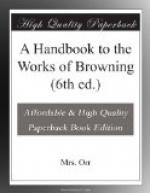Guided by these analogies—which he illustrates with much quaintness and variety—Caliban humours Setebos, always pretending to be envious of him, and never allowing himself to seem too happy. He moans in the sunlight, gets under holes to laugh, and only ventures to think aloud, when out of sight and hearing, as he is at the present moment. Thus sheltered, however, he makes too free with his tongue. He risks the expression of a hope that old age, or the Quiet, will some day make an end of his Creator, whom he loves none the better for being so like himself. And in another moment he is crouching in abject fear: for an awful thunderstorm has broken out. “That raven scudding away ’has told him all.’”
“Lo! ’Lieth flat and loveth Setebos!” (vol. vii. p. 161.)
and will do anything to please him so that he escape this time.
The most impressive of the dramatic monologues, “A Death in the Desert,” detaches itself from this double group. It is contemplative in tone, but inspired by a formed conviction, and, dramatically at least, by an instructive purpose; and thus becomes the centre of another small division of Mr. Browning’s poems, which for want of a less ugly and hackneyed word we may call “didactic.”
DIDACTIC POEMS.
The poems contained in this group are, taking them in the order of their importance,
“A Death in the
Desert.” Dramatis Personae. 1864.
“Rabbi Ben Ezra.”
Dramatis Personae. 1864.
“Deaf and Dumb:
a group by Woolner.” Dramatis Personae.
1864.
“The Statue and
the Bust.” Dramatic Romances. Published
in “Men and
Women.”
1855.
“A DEATH IN THE DESERT” is the record of an imaginary last scene in the life of St. John. It is conceived in perfect harmony with the facts of the case: the great age which the Evangelist attained: the mystery which shrouded his death: the persecutions which had overtaken the Church: the heresies which already threatened to disturb it; but Mr. Browning has given to St. John a foreknowledge of that age of philosophic doubt in which its very foundations would be shaken; and has made him the exponent of his own belief—already hinted in “Easter Eve” and “Bishop Blougram:” to be fully set forth in “The Ring and the Book” and “La Saisiaz”—that such doubt is ordained for the maturer mind, as the test of faith, and its preserver.
The supposed last words of the Evangelist, and the circumstances in which they were spoken, are reported by loving simplicity as by one who heard them, and who puts forward this evidence of St. John’s death against the current belief that he lingers yet upon earth. The account, first spoken, then written, has passed apparently from hand to hand, as one disciple after the other died the martyr’s death; and we find the MS. in the possession of an unnamed person, and prefaced by him with a descriptive note, in which religious reverence and bibliographical interest are touchingly blended with each other.




